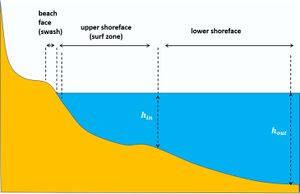Difference between revisions of "Shoreface"
Tasomerville (talk | contribs) m |
Dronkers J (talk | contribs) |
||
| (4 intermediate revisions by the same user not shown) | |||
| Line 1: | Line 1: | ||
{{Definition|title=Shoreface | {{Definition|title=Shoreface | ||
| − | |definition= The | + | |definition= The shoreface is the '''nearshore zone''' of the inner continental shelf that is bounded landward by the low-water line and that extends seaward to where the influence of wave action on sediment transport is on average minor compared to other influences.}} |
| + | |||
| + | [[File:ShorefaceUpperLower.jpg|thumb|300px|left|Schematic representation of a shoreface profile. ]] | ||
==Notes== | ==Notes== | ||
| − | The | + | A similar definition is: The shoreface is the zone seaward of the shoreline where offshore generated waves interact with the upward sloping seabed. The shoreface can be divided in two zones, the upper shoreface and the lower shoreface (also called [[Shoaling|shoaling zone]]). The upper shoreface is the zone where most energy is dissipated by wave overturning and breaking and the lower shoreface the zone where waves shoal. The lower part of the shoreface extends to the so-called outer [[closure depth]] <math>h_{out}</math>; beyond this depth the seabed is hardly influenced by waves and wave-induced sediment transport is (on average) insignificant. The transition between lower and upper shoreface is generally defined by the [[closure depth]] <math>h_{in}</math> related to the significant [[wave height]], which is exceeded 12 hours per year, <math>H_{s,12h/y}</math>. See [[Shoreface profile]]. |
| + | <br clear=all> | ||
| + | |||
| + | ==See also== | ||
| + | :[[Shoreface profile]] | ||
| + | :[[Closure depth]] | ||
| + | :[[Active coastal zone]] | ||
| + | :[[Definitions of coastal terms]] | ||
==References== | ==References== | ||
<references/> | <references/> | ||
| − | |||
| − | |||
Latest revision as of 19:12, 30 March 2021
Definition of Shoreface:
The shoreface is the nearshore zone of the inner continental shelf that is bounded landward by the low-water line and that extends seaward to where the influence of wave action on sediment transport is on average minor compared to other influences.
This is the common definition for Shoreface, other definitions can be discussed in the article
|
Notes
A similar definition is: The shoreface is the zone seaward of the shoreline where offshore generated waves interact with the upward sloping seabed. The shoreface can be divided in two zones, the upper shoreface and the lower shoreface (also called shoaling zone). The upper shoreface is the zone where most energy is dissipated by wave overturning and breaking and the lower shoreface the zone where waves shoal. The lower part of the shoreface extends to the so-called outer closure depth [math]h_{out}[/math]; beyond this depth the seabed is hardly influenced by waves and wave-induced sediment transport is (on average) insignificant. The transition between lower and upper shoreface is generally defined by the closure depth [math]h_{in}[/math] related to the significant wave height, which is exceeded 12 hours per year, [math]H_{s,12h/y}[/math]. See Shoreface profile.
